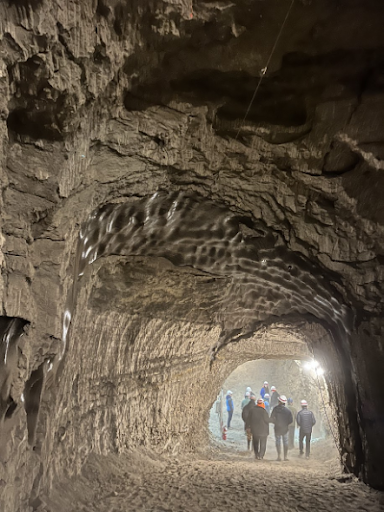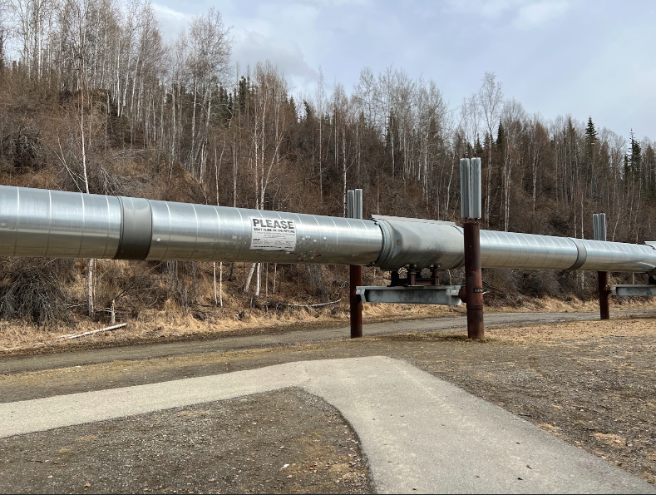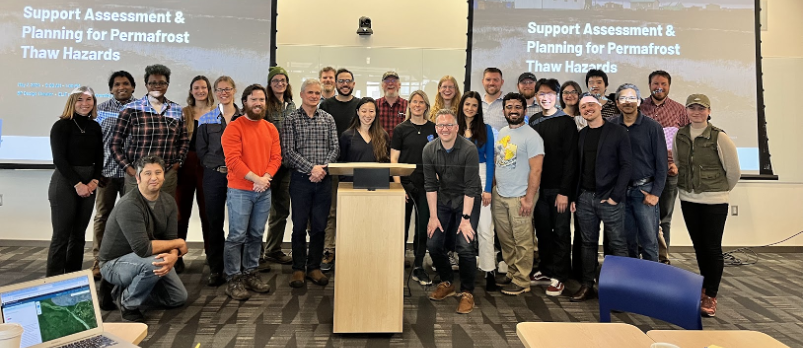
Permafrost Discovery Gateway imagery viewer showing ice-wedge polygon coverage in northern Alaska.
Highlight: Permafrost thaw is expected to cost Alaska $37-51 billion in building and road damages by 2050

The PDG development team on a precious tour of the CRREL Permafrost Tunnel, May 2024.
The Permafrost Discovery Gateway (PDG) is an online data visualization platform hosted by the Arctic Data Center that provides openly accessible permafrost conditions across the Arctic region for researchers, educators, and the public. The PDG leverages satellite imagery and artificial intelligence (AI) to create maps of lake change, retrogressive thaw slumps, wildfire areas, ice-wedge polygons, coastal erosion, infrastructure, and surface water. To help communities, researchers, and policymakers navigate the changing landscape, the team aims to provide automated monthly monitoring of permafrost thaw during the snow-free season.
The PDG received a $5 million investment from Google.org, which followed the initial $3 million grant from the National Science Foundation. This award has allowed the PDG to improve the user interface, increase scalability, implement AI workflows, and continue to support Arctic communities.
Permafrost Change in the Arctic
Thawing permafrost, triggered by warming and environmental disturbances, is releasing long-stored carbon and causing ground instability throughout the Arctic. This has extensive environmental and societal impacts such as:
-
Damage to infrastructure: thawing permafrost causes the ground to become unstable, leading to cracks, collapses, and sinking in roads, buildings, pipelines, and runways, directly impacting Arctic communities and industries.
- Public health and safety: thawing can expose old waste sites, buried pathogens, or contaminants, creating new health risks. Infrastructure damage can also limit access to medical care and emergency services.
- Economic costs: rebuilding or reinforcing damaged infrastructure comes at a high financial cost, particularly in remote Arctic regions where construction is already expensive and logistically challenging.
- Threats to communities: Changes in the land and environment caused by thaw can disrupt hunting, fishing, and travel routes, threatening local Arctic communities.
PDG in the News
The PDG has been featured in many news outlets, some of which are highlighted here. The full list of news coverage, presentations, and publications can be found here.
February 2024
15 Google Fellows joined the PDG in early 2024 to help gather spatial data, refine machine learning models focused on detecting permafrost thaw, and redesigning the user interface to meet the needs of local communities and decision makers. This article covers more about the involvement of the Fellows.
October 2024

Pipeline viewing area just north of Fairbanks, May 2024.
Late last year, the Interagency Arctic Research Policy Committee (IARPC) Collaborations Risk Team hosted a webinar by PDG Principal Investigator Anna Liljedahl. The presentation focused on ways the PDG is empowering Alaskan agencies and community leaders to use geospatial data to gain information about the landscape and infrastructure impacted by permafrost thaw. The full webinar can be found on YouTube.
April 2025
Recently, the Anchorage Daily News and Alaska Native News featured a study in Nature Communications Earth and Environment by Elias Manos, Chandi Witharana, and Anna Liljedahl of the PDG team that explores permafrost thaw-related infrastructure damage costs in Alaska. They found permafrost thaw is expected to cost Alaska $37-51 billion in building and road damages by 2050 and discuss the drawbacks of existing U.S. national risk assessments as they neglect to account for Alaska permafrost hazards.
Navigating the PDG Portal
The Permafrost Discovery Gateway portal Imagery Viewer allows users to view permafrost coverage of the Arctic region and includes layers related to people, lakes and surface water, permafrost, carbon balance, and various basemaps showing satellite imagery, topography, and more. The next tab links to the Fluid Earth Viewer by The Ohio State University’s Byrd Polar and Climate Research Center which shows atmospheric and ocean patterns across the globe, including an estimate of permafrost probability. The PDG portal also includes information about the project’s mission, impact, cyberinfrastructure, funding, and team members. To stay connected to the PDG project, consider joining their monthly virtual webinar series by adding it to your calendar here. You can find a tutorial on using the PDG at pdg.open.uaf.edu/using-pdg/ and a list of all Arctic Data Center portals at arcticdata.io/catalog/portals.
The June ADC Dataset Highlight will feature PhD student and PDG team member Elias Manos. Stay tuned for more!

The PDG end-user workshop in Fairbanks May 2024 with many of the developers, including the Google Fellows.
Written by Nicole Greco
Community Engagement & Outreach Coordinator
